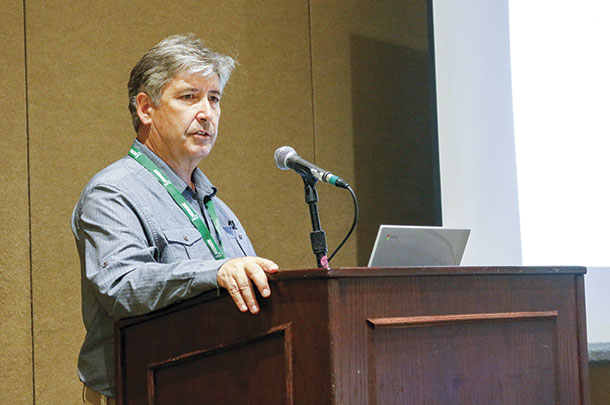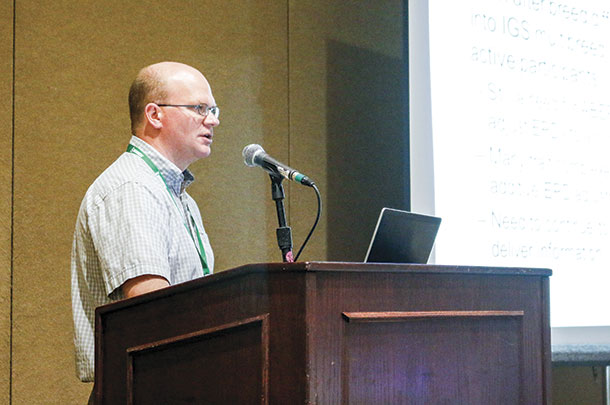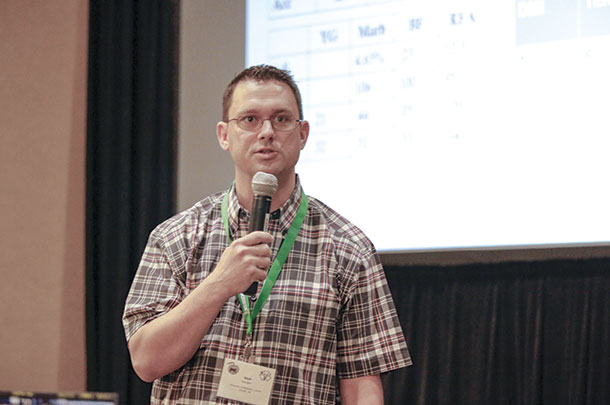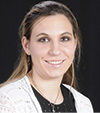The panel discussion, titled “Implications of multibreed evaluations and across-breed EPDs for commercial cattlemen” consisted of four representatives with different industry perspectives and involvement. The panelists featured were Bruce Golden of Theta Solutions, Larry Kuehn of the Meat Animal Research Center (MARC), Matt Spangler of the University of Nebraska and Joe Epperly of the National American Limousin Foundation (NALF).
They discussed what technologies are available today, industry goals and the direction this cause will take in the future.

Bruce Golden
The BOLT software system
First up on the panel was Bruce Golden, the co-founder, CEO and president of Theta Solutions. Golden helped develop the Biometric Open Language Tools (BOLT) software for evaluating multibreed EPDs.
BOLT utilizes both genomic and phenotypic data and is able to produce accurate EPD values on a common base.
Under a contract with International Genetic Solutions (IGS), the software is made available to all company partners. “We’ve got 12 breed associations (currently involved),” he said. “We’ve also got breeds involved in this that aren’t affiliated with the breed association members that contract IGS for production.”
That breaks down to about 16 million animals in analysis, with 12 million actually “hooked” in to direct observation. According to Golden, they have around 15 different EPD evaluations underway.
Most breed associations currently use Cornell-based software and other traditional methods to obtain their EPDs. BOLT is a step above these, picking up on things they can’t do. A big one is incorporating genomics, something the Cornell software can’t do. “There’s a lot of genomic data,” Golden said.
“Right now, we’re at 79,000 usable genotyped animal records in this dataset and growing quickly on that.” He said they also want the system powerful enough to run on a weekly basis for consistent updates. Improving on the accuracy of difficult traits like cow fertility is another goal.”
“Most importantly, the goal is to create proven, accurate EPDs for use between different breeds that everyone can agree upon. Fortunately, Golden sees a lot of hope for that. “Generally, we’re getting really good agreement,” he said. “We have a lot of good evidence within contemporary groups for Sim USA sires … so that’s very hopeful, especially when you start looking at other breeds.”
 Larry Kuehn
Larry Kuehn
MARC research and data in use
Larry Kuehn, a research geneticist, next spoke about MARC data available and how it is being used to calculate adjustment factors. With fewer universities doing genetics research, MARC is leading this work.
“We’re trying to make sure we’re representing industry-relative sires based on usage of those sires within their perspective breeds every year,” he said.
Currently, MARC data calculates adjustment factors across breeds for growth and carcass trait EPDs in 18 different breeds. Everything uses a common Angus base of zero to adjust to.
“These are not breed differences,” Kuehn noted. “These are factors that tell you what (the) breed differences are.” Kuehn said they want to reach a point where there is no longer a need for the different factors on an equal multibreed scale. “We want to get to a point where the adjustment factor is the same for every animal in the multibreed relative to Angus,” he said.
Kuehn mentioned this data is still in a prototype stage for usage in the BOLT software – and neither is flawless. A lot of error in the MARC data is due to sampling and random error. “If it’s one thing that’s important (to remember) is: All breeds are not part of IGS multibreed,” he said. “We will still need some sort of table or some sort of method to process data in order to allow producers to compare equally across all breeds.”
 Joe Epperly
Joe Epperly
Breed association impacts
Joe Epperly spoke on behalf of the breed associations involved. The NALF is a group working in cooperation with the IGS project.
To understand where the issues are, he pointed out the U.S. beef herd has approximately a 35-million-head calf crop. “They’re the ones we want to improve,” Epperly said of where the research is being directed.
“All told, everything we do, we want to come through commercial cattlemen and come through the plate. So all our decisions are going to them.”
Only pedigreed calves, he explained, are contributing to the data. The problem is: They make up a small portion of the total herd – only around 750,000 head. “This is where bias comes in,” he said.
“Maybe this is one of the problems … one of our challenges with breed associations as we move forward is: This is where we produce a lot of bias. It’s even in the IGS system.” He also noted EPDs are only averages; he explained their usage as being “macro-tools for macro-decisions” – looking at the big picture more than individual animals.
Overall, he highlighted the importance of cooperation between the breed associations and producers. Regardless of what technologies are used, both are needed to make the best possible mating and management decisions.
“We’re going to use those across-breed adjustments to guide our cross-breeding efforts and make those decisions then on a micro-level picking the right type of bull,” he said. “(But) be sure to use your breed associations as much as possible when making those hybrid matings rather than trying to do that on your own. That’s just a recipe for disappointment if you don’t use those tools available to you.”
 Matt Spangler
Matt Spangler
Summary: A geneticist’s perspective
Matt Spangler, speaking as a livestock geneticist, concluded the panel with a summary and discussion of where this information might go.
He explained the importance of finding solutions for EPDs across breeds. He said of the mission, “(It) helps facilitate educated bull buying decisions for commercial producers who elect to use more than one breed of sire in some kind of structured cross-breeding program.”
It will also help to reduce confusion in the disjointed national evaluations based on breed effects and bias.
He warns the multibreed evaluation does not mean they are equally comparable. For certain traits, definitions can vary across the breed spectrum or given different priority. “I think one part of the confusion,” he said, “is that pervasive thought multibreed genetic evaluation somehow inherently means the resulting EPDs will be comparable across breed contained in evaluation. That’s not at all true.”
Since breeds don’t share a unified pedigree tie, it’s genetically and scientifically impossible for them to be completely comparable. Therefore, the base adjustment needs to be common and agreed upon. “A breed adjustment has nothing to do with science,” Spangler said. “Base is designed on perceived marketing advantages, and that’s really all it is. There need to be common trait definitions … there also need to be common underlying models.” ![]()

-
Jaclyn Krymowski
- Editorial Intern
- Progressive Cattleman









